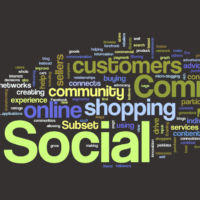Social shopping – Why Omnichannel Is Not Enough
by Hugh Williams on 21st Dec 2018 in News


Omnichannel is out. Unified experience is everything. In this piece for RetailTechNews, Oliver Guy, global industry director of retail, Software AG, explains why it is high time retailers started using a unified approach for customers; he calls it 'social shopping'.
Connected technologies – such as IoT for stock monitoring, interactive displays within stores, and smart pricing – have the potential to transform retail operations; but these connected technologies can also be applied to the shopping experience to literally ‘do what Amazon cannot do’.
Too often, retailers think that omnichannel is a synonym for 'multichannel', rather than a single, unified experience where insight is gathered and shared across different customer touchpoints of online, mobile, and physical stores. The problem with the multichannel approach is that it often silos each aspect of customers’ paths to purchase, where they should be working together to provide a better experience for consumers and more data-led insight for retailers.
With nearly a third of consumers now shopping on a mobile device, delivering a unified experience is vital. So, how do retailers ensure they are capturing their customers’ attention, data and, ultimately, their business?
Social-savvy consumers
As the chancellor recognised in his Autumn Budget, the UK has embraced online retail like no other advanced economy; indeed 87% of all purchases are made online according to the Royal Mail. But it’s not just about how we buy things, but also how we research them – our paths to purchase – that retailers need to get a handle on.
Instagram is particularly influential in the retail space, and the majority of users access it via the app on mobile devices, meaning they are just a few taps from retailers’ websites and making purchases. A recent study by Facebook found that around 300 million people use Instagram stories daily and that many use it to “stay in the know with brands they're interested in, get an insider view of products they like, and find out about new products that are relevant to them”. Instagram is currently working on a new standalone app that is dedicated to shopping, which is rumoured to let users browse collections of goods from merchants that they follow and then purchase them directly within the app.
The immediacy and ease of social apps, coupled with an ever-increasing range of integrated mobile payment options, makes social channels a powerful tool for retailers. But as as consumers are more and more familiar with mobile shopping, retailers must ensure their channels are easy to use, across any device.
Faster and easier shopping methods are key to delivering the customer experience. In order to attract the new generation of shoppers, it is vital that retailers are not only social-ready, but they are delivering a truly joined-up experience across channels.
For example, if your customer opens Instagram and 'likes' a photograph of merchandise from your range, you need to know. Indeed, if a customer accesses Instagram on their mobile, then clicks a link for your products and goes through to your app or mobile site, then puts that item in their basket, this same item should be shown in their basket if they were to log in online via a desktop or laptop browser – all purchasing options need to be linked.
Internet brands such as Misguided, PrettyLittleThing, and boohoo.com are the poster brands for the new breed of fast, millennial-first fashion. These brands aren’t just successful because their slick presentation and user experience have helped them amass millions of fans on social media, or because they are constantly collaborating with influencers within their target audience. It’s because they are treating social media as a sales platform, and connecting data from all their channels (in-store, online, mobile) to deliver personalised content and targeted advertising to consumers. But they have also been built to be internet first – giving them a huge advantage over older retailers with more legacy technology.
So, how do retailers keep up?
In the new, always-on age, shopping never stops. In order to keep customers’ attention, it is vital that retailers have a fully joined-up approach, from their own web and mobile sites, through to apps and social media channels and down to the delivery of merchandise – and even returns, customer feedback, and product reviews. An omnichannel approach across businesses is no longer a 'nice to have'; it’s not even enough anymore.
In order to create a unified experience for customers, retailers need to ensure their technology framework is flexible. Their approach needs to support innovation at scale by being able to orchestrate new processes across multiple existing systems, while being flexible enough to utilise new technology such as artificial intelligence, machine learning, and the Internet of Things, when appropriate.
Digital transformation means making organisational changes and leveraging new technology to enable business change; it enables retailers to exploit new business models and revenue-generating opportunities, but also future-proofs them to allow for further innovation. In the current research landscape, digital transformation is critical for retailers so they are able to deliver the best, unified experience to customers, they will no longer settle for anything less. Shopping has to be social. And unified.




Follow Fast Growth Brands